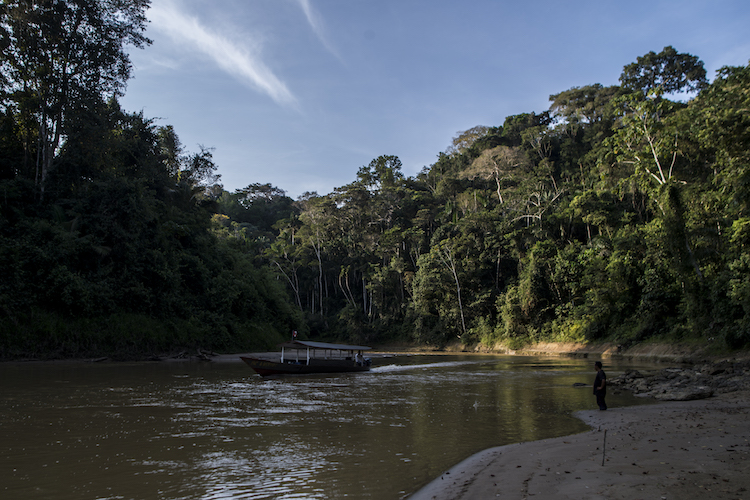By Fabíola Ortiz
STOCKHOLM (IDN) – Indigenous peoples are all but invisible on the development agenda but a hoped for change is on the cards with the launch of the world’s first and only funding institution to support the efforts of local and native communities to secure rights over their lands and resources.
“Include us, so that we can protect our lands for our children and protect the planet’s biodiversity for all the world’s children,” said by Victoria Tauli-Corpuz, UN Special Rapporteur on the Rights of Indigenous Peoples during the launch. Recognising the land rights of native and traditional peoples is a low-cost solution toward achieving the world’s development, environment and climate agendas. JAPANESE | SPANISH
Known as the International Land and Forest Tenure Facility, the new institution dedicated to scaling up the recognition of collective land and forest rights was officially presented on October 3 during a conference in Stockholm organised by the Swedish government, the Ford Foundation and the Rights and Resources Initiative (RRI).
For most indigenous people, “land is everything,” continued Tauli-Corpuz. Having secure rights over their lands ensures that “they can feed their families and practise their culture and traditional knowledge.”
Almost 2.5 billion people, one-third of the world’s population, depend on community-held lands for their livelihoods. They manage more than half the planet’s land area in traditional systems, yet indigenous peoples and local communities have formal legal ownership of only 10% of the world’s lands, according to a 2015 RRI report.
The Tenure Facility will invest 10 million dollars a year for the next decade in titling projects. This funding could increase titled, protected tropical forestland by 40 million hectares, preventing the emission of more than 0.5 gigatonnes of carbon dioxide.
It will work with indigenous and community leaders to take advantage of laws that are already on the books to strengthen their rights, said RRI coordinator Andy White, stressing that the Tenure Facility is aligned with the United Nations’ Sustainable Development Goals (SDGs) and the Paris Agreement on climate change.
“Indigenous peoples have cared for the forests for centuries, despite increasing pressure from governments and private interests that want access to the land and its soil, the timber in the trees and the minerals in the ground below,” said White.
The Tenure Facility has kicked off with six pilot projects in Africa, Asia, and Latin America covering two million hectares of forest in six countries – Cameroon, Indonesia, Liberia, Mali, Panama and Peru.
The tropical rainforest in Peru, which is part of the Amazon basin, is an interesting case in which more than half of the country’s territory is forest, and much of that land is occupied by indigenous people.
After Bolivia, Peru is the South American country with the second highest proportion of indigenous population. Approximately 20 million hectares are pending titling in favour of indigenous people – corresponding to 15 percent of Peruvian territory.
“We cannot design public policies and conservation strategies without including the indigenous,” Silvana Baldovino, programme director of the Peruvian Society for Environmental Law, told IDN. “We cannot create rules inside a cabinet without speaking to the native peoples. It would be illogical to draw conservation policies without engaging who are actually on the ground.”
Baldovino was in Stockholm to talk about the successful Peruvian case of titling and managing forests. “Madre de Dios has a large percentage of its region as protected natural areas. It is important for the indigenous peoples to have their land demarcated. It is a historic debt,” he said.
The tropical Madre de Dios region in the southeast part of Peru covers 800,000 hectares and is under constant pressure from illegal logging, gold mining and oil exploration.
In the region, there are seven indigenous peoples living in 36 communities. Many of these communities require legal and physical clarification of their territorial claims before they can secure their titles.
This first pilot project supported by the Tenure Facility helped to map five communities. Over 112,000 hectares were geo-referenced, enabling three communities to actually obtain the title of their land.
Securing tenure would also set the stage for more sustainable and equitable development, as well as reducing conflict over land, agrees Nonette Royo, the Tenure Facility’s executive director.
“The whole world is looking at the Amazon forest,” she told IDN. “At the moment, the indigenous peoples are experiencing such a huge challenge: they occupy places where most of the forests are still growing and stand. They have protected these places for generations.”
At least one-quarter of the carbon stored above the ground in the tropical forests is found in the collectively managed territories of indigenous peoples and local communities, according to a study released in November 2016.
This amount represented 70 percent of what was emitted globally in 2015, according to the International Energy Agency. [IDN-InDepthNews – 7 October 2017]
Photo: Courtesy Tenure Facility / Madre de Dios region, Peruvian Amazon.




